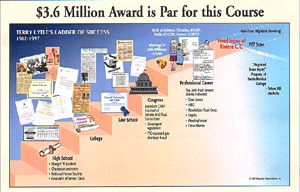Lytle v. Riviera Country Club
On July 28, 1993 Plaintiff, a 47 year-old anti-trust
lawyer, was golfing as a guest at Defendant Riviera
Country Club. As he started to take his driver out of
his golf bag at the third tee, a bulldozer operator
came up a hill from behind and drove directly into Plaintiff
at a low speed, hitting him in the head. Plaintiff was
knocked unconscious at the scene. He had a quarter-inch
cut to the back of his head which was closed without
stitches.
A CT scan and MRI failed to show any brain damage.
Plaintiff as followed by a neurologist who noted continuing
headaches. With time Plaintiff felt he "wasn't
thinking the same," and his doctors though he might
benefit from neuropsychological care. Plaintiff returned
to work, but headaches and cognitive difficulties made
him feel he could not properly represent his clients
and so he gradually withdrew from a lucrative practice.
Over the next three years, Plaintiff never returned
to regular employment. due to financial difficulties,
Plaintiff's family moved to a smaller home. Plaintiff
was a Princeton undergraduate and received his law degree
from Cornell. He was tested at a 140 IQ at age 12.
 Plaintiff
said that he suffered a concussion. Plaintiff's biomechanical
expert contended the impact could have been as high
as 56Gs in 5-10 milliseconds - violent enough to cause
a concussion; that the SPECT/PET scans corroborated
the cognitive deficits found in neuropsychological tests;
that Plaintiff suffered an altered state of consciousness.
Plaintiff presented testimony of percipient witnesses,
including several very prominent professionals, to established
Plaintiff "was not the same man" after the
accident. Plaintiff
said that he suffered a concussion. Plaintiff's biomechanical
expert contended the impact could have been as high
as 56Gs in 5-10 milliseconds - violent enough to cause
a concussion; that the SPECT/PET scans corroborated
the cognitive deficits found in neuropsychological tests;
that Plaintiff suffered an altered state of consciousness.
Plaintiff presented testimony of percipient witnesses,
including several very prominent professionals, to established
Plaintiff "was not the same man" after the
accident.
Defense Conceded liability at trial, but contended
that Plaintiff suffered from only a "conversion
disorder" and a little cut with mild swelling;
that he might have sprained his neck and suffered some
headaches. Defense expert Waxman testified that the
evidence of brain injury offered by Plaintiff was experimental
and useless to diagnose a traumatic brain injury. Defense
argued that the medical evidence proved there was no
brain injury; that all of five MRI's and CT scans were
normal; that only a PET scan and two SPECT scans introduced
by Plaintiff were argued to be abnormal; that there
was not a sufficient normal database for these tests;
that no medical organization was recognized or approved
such test for minor head trauma. Defendant's psychological
expert testified that she tested Plaintiff's PIQ/VIQ
difference; that he tested at 24, which was normal for
lawyers; that Plaintiff's FSIQ of 115 was unaffected
by the injury.
|